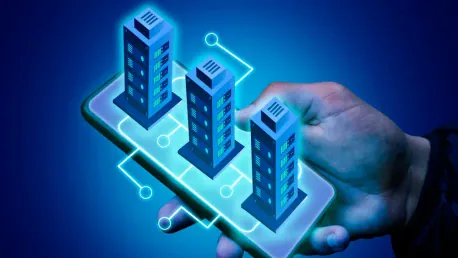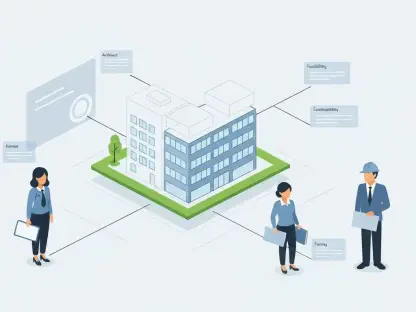The advent of intelligent building technology has revolutionized everything from homes to commercial buildings, factories, and warehouses. It has altered how large and small facilities are managed, primarily for the better. While “smart” building systems and BMS/EMS have been around for decades, future efficiency gains are being realized by integrating disjointed systems such as lighting, HVAC, security, and access control onto a single network. This integration allows data to be used between these silos to drive better insight and action. However, this convergence brings new challenges, particularly in cybersecurity and interoperability. This article guides facility executives on navigating the converged smart building landscape and evolving IT standards to ensure security and seamless operation.
1. Conduct a Risk Assessment
Before implementing any IT standards, it’s crucial to conduct a comprehensive risk assessment to identify potential vulnerabilities and threats. This assessment needs to include an inventory of every facility-related system that exists, even if it is not connected to a network yet. Identifying these systems will help you understand the specific risks your smart building faces and tailor your security measures accordingly. Additionally, it can guide you in understanding what is missing from a data perspective and which systems or devices must be added to enable a comprehensive and unified intelligent building. Older systems will often require some form of bridging from legacy protocols to Ethernet, ensuring they can communicate effectively within the modern, integrated network.
With the risk assessment in hand, facility managers can prioritize areas that require immediate attention versus those that can be addressed later. For example, legacy systems that are critical to operations yet vulnerable due to outdated protocols must be upgraded or bridged to modern standards first. During the risk evaluation process, it is also essential to engage various stakeholders, including IT departments, operations teams, and vendor partners. Collaborating with these groups ensures that all potential risks and dependencies are addressed, creating a more resilient security framework. This participatory approach not only helps in identifying vulnerabilities but also fosters a culture of security awareness and preparedness.
2. Create a Security Strategy
A security policy outlines the rules and procedures for protecting your smart building systems, including guidelines for password management, access control, data encryption, and incident response. Ensure that all employees are aware of the policy and understand their responsibilities. This can be time-consuming, but documenting this provides a framework that should be done with the IT organization to explain the scope of the systems and the desires for data from each. A well-crafted security policy is the cornerstone of an effective cybersecurity strategy, clearly defining what is expected in terms of behavior, protocol, and response.
Having a security strategy not only sets the foundation for daily operations but also prepares the organization to respond effectively to security incidents. Regularly reviewing and updating the security policy is essential, given the fast-paced nature of cyber threats. Additionally, incorporating feedback from initial risk assessments and ongoing monitoring activities can help refine the policy. By making the security strategy a living document, facility managers can ensure it remains relevant and effective in addressing both existing and emerging threats. Aligning the security policy with industry standards and best practices, such as those provided by BACnet, NIST, or ISO/IEC 27001, also adds a layer of robustness, making it easier to mitigate risks comprehensively.
3. Apply Security Measures
Based on your risk assessment and security policy, implement appropriate security controls. These may include firewalls, intrusion detection systems, antivirus software, and multi-factor authentication. Importantly, these need to be regularly updated to address new threats. An important choice needs to be made here as to who will administer these policies in the future. It is highly recommended that the IT organization has control here, as they will be the first to identify risks. Applying security measures is not a one-time activity; it requires continuous management and adaptation to keep up with evolving threats.
Implementing these security measures should focus on creating a multi-layered defense strategy, often referred to as defense in depth. This approach ensures that if one layer fails, multiple other defensive measures are in place to prevent a breach. Use firewalls to create barriers between different network segments, deploy antivirus software to detect and mitigate malware, and implement intrusion detection systems to identify and respond to unauthorized access attempts. Multi-factor authentication adds an extra layer of security by requiring users to verify their identity through multiple means, which can significantly reduce the risk of unauthorized access due to compromised passwords. Regularly updating and patching these systems is vital to protect against new vulnerabilities and threats.
4. Educate Your Personnel
Educating your staff on cybersecurity best practices and the importance of adhering to IT standards is crucial for the security of converged smart buildings. Most breaches are not complex and can be as simple as a phishing email for a password. People uneducated on security are the largest threats to organizations. By providing regular training sessions and updates on the latest security threats and best practices, facility managers can equip their staff with the knowledge needed to recognize and respond to potential threats. This proactive approach to education can significantly reduce the likelihood of security incidents caused by human error.
Developing a comprehensive training program involves more than just one-off sessions; it should be an ongoing initiative that evolves with the changing cybersecurity landscape. Incorporating simulated phishing attacks and other practical exercises can help employees understand the real-world implications of their actions and decisions. Additionally, fostering a culture of openness and communication regarding security concerns can encourage employees to report suspicious activities or vulnerabilities without fear of retribution. By making cybersecurity a shared responsibility, rather than solely an IT concern, facility managers can create a more resilient defense against threats.
5. Observe and Evaluate
IT organizations should continuously monitor the infrastructure for patches, software updates, and signs of suspicious activity. Regularly review your security measures and parameters, and update them regularly to address new threats. Continuous monitoring allows for the early detection of potential issues, enabling timely intervention before they escalate into significant problems. Observing and evaluating the efficacy of implemented security measures also helps in identifying areas where additional improvements or adjustments may be necessary, ensuring that the security posture remains robust and effective.
The process of observation and evaluation should include regular audits and compliance checks to ensure that all systems and practices adhere to established security policies and industry standards. Automated monitoring tools and analytics can provide real-time insights into network activity and potential vulnerabilities, facilitating prompt responses to emerging threats. Additionally, conducting periodic penetration tests and security assessments can help identify weaknesses that may not be apparent through routine monitoring alone. By staying vigilant and proactive in their approach, facility managers can create a dynamic and adaptive security framework that evolves in response to the changing threat landscape.
Conclusion
A security policy details the rules and procedures to safeguard your smart building systems, covering password management, access control, data encryption, and incident response. All employees must be aware of the policy and understand their roles, which can be a time-consuming task. However, documenting this policy with the IT team provides a structured framework that explains the system’s scope and data needs. A well-designed security policy is fundamental to a robust cybersecurity strategy, clearly outlining expected behaviors, protocols, and responses.
Establishing a security strategy not only sets the foundation for everyday operations but also equips the organization to respond effectively to security incidents. It’s crucial to regularly review and update the security policy due to the fast-evolving nature of cyber threats. Incorporating insights from initial risk assessments and ongoing monitoring can help refine the policy. Making the security strategy a dynamic document ensures it stays relevant and effective against current and emerging threats. Aligning with industry standards like BACnet, NIST, or ISO/IEC 27001 adds another layer of security, facilitating comprehensive risk mitigation.









